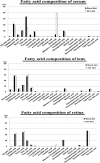Mead acid supplementation does not rescue rats from cataract and retinal degeneration induced by N-methyl-N-nitrosourea
- PMID: 26023256
- PMCID: PMC4337494
- DOI: 10.1293/tox.2014-0036
Mead acid supplementation does not rescue rats from cataract and retinal degeneration induced by N-methyl-N-nitrosourea
Erratum in
-
Errata (Printer's correction).J Toxicol Pathol. 2016 Jan;29(1):74. Epub 2016 Feb 17. J Toxicol Pathol. 2016. PMID: 26989306 Free PMC article.
Abstract
Fatty acids and their derivatives play a role in the response to ocular disease. Our current study investigated the effects of dietary mead acid (MA, 5,8,11-eicosatrienoic acid) supplementation on N-methyl-N-nitrosourea (MNU)-induced cataract and retinal degeneration in Sprague-Dawley rats. Experiment 1 was designed to inhibit cataract formation, with the dams fed a 2.4% MA or basal (<0.01% MA) diet during lactational periods. On postnatal day 7, male pups received a single intraperitoneal (ip) injection of 50 mg/kg MNU or vehicle. Lens opacity and morphology were examined 7 and 14 days after the MNU injection. Experiment 2 was designed to inhibit retinal degeneration and was performed with female postweaning rats. In this experiment, dams were fed the 2.4% MA or basal diet during the lactational periods. Thereafter, the female pups were continuously fed the same diets during their postweaning periods. On postnatal day 21 (at weaning), pups received a single ip injection of 50 mg/kg MNU. Retinal morphology was examined 7 days after the MNU injection. In experiment 3, six-week-old female rats were fed the 2.4% MA or basal diet starting at one week before the MNU injection and were then continuously fed the same diets until sacrifice. Rats at 7 weeks of age were given a single ip injection of 40 mg/kg MNU, and the retina was then examined morphologically one week after the MNU injection. In experiment 1, mature cataract was found in all of the MNU-treated groups, with or without MA supplementation. In experiments 2 and 3, atrophy of both the peripheral and central outer retina occurred in all rats exposed to MNU, with or without MA supplementation, respectively. The severities of the cataracts and retinal atrophy in the rats were similar regardless of MA supplementation. Dietary mead acid, which is used as a substitute in essential fatty acid deficiency in the body, does not modify MNU-induced cataract and retinal degeneration in rat models.
Keywords: N-methyl-N-nitrosourea; arachidonic acid; cataract; mead acid; rats; retinal degeneration.
Conflict of interest statement
Figures





References
-
- World Health Organization (WHO), Prevention of Blindness and Deafness Programme Global Data on Visual Impairments 2010. 2012. Retrieved July 15, 2014, from World Health Organization Web site: http://www.who.int/blindness/GLOBALDATAFINALforweb.pdf.
-
- Hartong DT, Berson EL, and Dryja TP. Retinitis pigmentosa. Lancet. 368: 1795–1809 2006. - PubMed
-
- Tsubura A, Yuri T, Yoshizawa K, Uehara N, and Takada H. Role of fatty acids in malignancy and visual impairment: epidemiological evidence and experimental studies. Histol Histopathol. 24: 223–234 2009. - PubMed
LinkOut - more resources
Full Text Sources
Other Literature Sources
